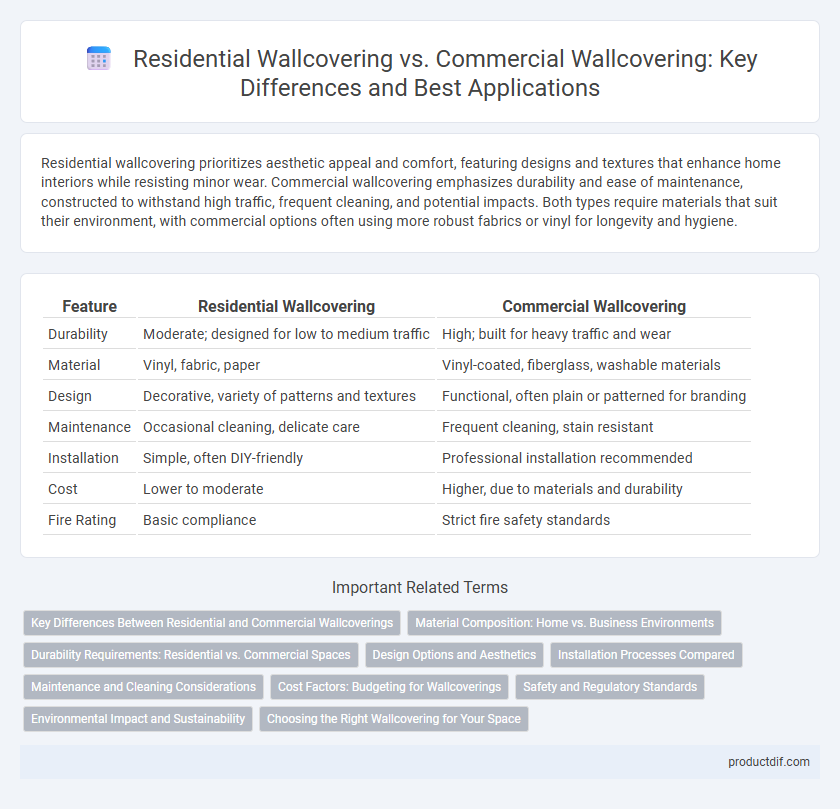Residential wallcovering prioritizes aesthetic appeal and comfort, featuring designs and textures that enhance home interiors while resisting minor wear. Commercial wallcovering emphasizes durability and ease of maintenance, constructed to withstand high traffic, frequent cleaning, and potential impacts. Both types require materials that suit their environment, with commercial options often using more robust fabrics or vinyl for longevity and hygiene.
Table of Comparison
| Feature | Residential Wallcovering | Commercial Wallcovering |
|---|---|---|
| Durability | Moderate; designed for low to medium traffic | High; built for heavy traffic and wear |
| Material | Vinyl, fabric, paper | Vinyl-coated, fiberglass, washable materials |
| Design | Decorative, variety of patterns and textures | Functional, often plain or patterned for branding |
| Maintenance | Occasional cleaning, delicate care | Frequent cleaning, stain resistant |
| Installation | Simple, often DIY-friendly | Professional installation recommended |
| Cost | Lower to moderate | Higher, due to materials and durability |
| Fire Rating | Basic compliance | Strict fire safety standards |
Key Differences Between Residential and Commercial Wallcoverings
Residential wallcoverings prioritize aesthetic appeal, offering diverse patterns, textures, and colors tailored to personal taste, while commercial wallcoverings emphasize durability, fire resistance, and easy maintenance to comply with safety regulations. Residential options often use vinyl-coated or fabric-backed paper for comfort and design variety, whereas commercial types feature heavy-duty materials like vinyl or fiberglass designed to withstand high traffic and frequent cleaning. Furthermore, commercial wallcoverings meet stringent standards such as ASTM E84 for flame spread and smoke development, ensuring safety in public and workplace environments.
Material Composition: Home vs. Business Environments
Residential wallcoverings typically utilize softer, more decorative materials such as vinyl-coated paper, fabric, or natural fibers that prioritize aesthetic appeal and comfort. Commercial wallcoverings often incorporate high-durability materials like heavy-duty vinyl, fiberglass, or PVC to withstand frequent cleaning, impact, and higher traffic conditions. The material composition directly reflects the functional demands, with residential designs focusing on ambiance and commercial options emphasizing durability and maintenance efficiency.
Durability Requirements: Residential vs. Commercial Spaces
Residential wallcoverings prioritize aesthetic appeal and moderate durability, designed to withstand everyday wear such as occasional cleaning and minor abrasions. Commercial wallcoverings demand higher durability standards, engineered to resist heavy traffic, frequent cleaning protocols, and potential vandalism in public or high-use areas. Materials like vinyl and reinforced fabrics are common in commercial settings to ensure longevity and maintain appearance under rigorous conditions.
Design Options and Aesthetics
Residential wallcovering offers a wide range of design options focused on personal style, featuring textured fabrics, intricate patterns, and warm color palettes that enhance home comfort and aesthetics. Commercial wallcovering prioritizes durability and professional appeal, with sleek, minimalist designs, high-performance materials, and neutral tones that suit corporate environments and high-traffic areas. Both types cater to specific functional needs while providing tailored aesthetic solutions optimized for either residential warmth or commercial sophistication.
Installation Processes Compared
Residential wallcovering installation often involves smaller spaces with more intricate detailing, requiring precise pattern matching and careful surface preparation to ensure aesthetic appeal and durability. Commercial wallcovering installation emphasizes efficiency and speed, utilizing pre-pasted or heavy-duty materials designed to withstand higher traffic and frequent cleaning. Professional installers typically use specialized tools and techniques tailored to the project scale, ensuring seamless application and lasting performance in both environments.
Maintenance and Cleaning Considerations
Residential wallcoverings typically require gentler cleaning methods such as light dusting or spot cleaning with mild soapy water to preserve delicate materials, while commercial wallcoverings demand durable, stain-resistant surfaces that can withstand frequent, rigorous cleaning using stronger detergents or steam cleaning. High-traffic commercial areas often use vinyl or coated wallcoverings designed for easy maintenance, whereas residential spaces favor aesthetic appeal with materials that may be more susceptible to wear and require careful upkeep. Understanding these maintenance distinctions ensures longevity and appearance tailored to the functional needs of the environment.
Cost Factors: Budgeting for Wallcoverings
Residential wallcovering costs are influenced by factors such as material type, design complexity, and installation methods, often prioritizing aesthetic appeal within a homeowner's budget. Commercial wallcovering expenses typically include considerations for durability, fire resistance, and maintenance requirements, leading to higher initial investments but longer service life. Budgeting for wallcoverings requires evaluating usage context, with commercial projects demanding cost-effective solutions that meet safety codes and functional needs.
Safety and Regulatory Standards
Residential wallcoverings typically adhere to less stringent safety and regulatory standards compared to commercial wallcoverings, which must comply with rigorous fire resistance, durability, and hygiene regulations to meet building codes. Commercial wallcoverings often require certifications such as Class A fire ratings under ASTM E84 to ensure occupant safety in high-traffic environments. In contrast, residential wallcoverings prioritize aesthetic appeal with moderate safety standards focused on indoor air quality and allergen control.
Environmental Impact and Sustainability
Residential wallcoverings often prioritize eco-friendly materials like natural fibers, low-VOC adhesives, and recyclable substrates to minimize environmental impact and enhance indoor air quality. Commercial wallcoverings emphasize durability and compliance with strict sustainability certifications such as GREENGUARD and LEED, ensuring reduced emissions and longer lifecycle performance in high-traffic areas. Both residential and commercial options increasingly integrate sustainable production practices, including water-based inks and renewable resources, to support environmental responsibility.
Choosing the Right Wallcovering for Your Space
Residential wallcovering emphasizes aesthetic appeal, comfort, and personalization to enhance home environments, utilizing materials like vinyl, fabric, and textured wallpapers. Commercial wallcovering prioritizes durability, ease of maintenance, and compliance with safety standards, often incorporating heavy-duty vinyl, antimicrobial coatings, and fire-resistant features. Choosing the right wallcovering involves assessing traffic levels, environmental conditions, and design goals to ensure both functionality and style align with the space's specific needs.
Residential Wallcovering vs Commercial Wallcovering Infographic

 productdif.com
productdif.com